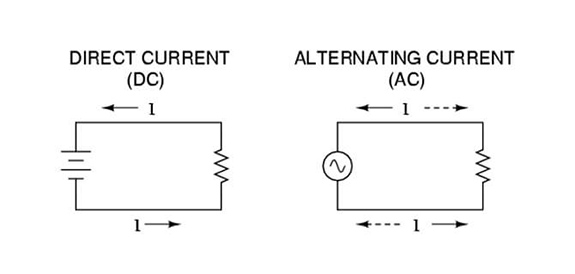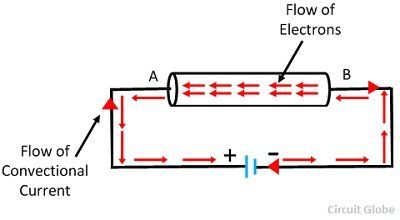Describe How Electric Currents Flow in Circuits
Electric current is described as moving from the positive to the negative end of the circuit. Flow of electricity.

What Is Electric Current Definition Direction Of Flow Of Current Youtube
Relationships in Series Circuits.

. Kirchhoffs Current Law also known as Kirchhoffs Junction Law and Kirchhoffs First Law define the way that electrical current is distributed when it crosses through a junctiona point where three or more conductors meet. It is measured as the net rate of flow of electric charge through a surface or into a control volume. Electrical current exists in two types.
136 ENERGY AND CHANGE. Some of the current passes through both of the branches. The voltage in AC circuits also periodically reverses because the current changes direction.
92 Briefly describe the flow of electrical current in this circuit. For a circuit to work it must be a complete closed loop. T is the time of flow in seconds.
The unit of electric current is the ampere A. The flow of current in a circuit is similar to this flow of water. It is said that there is a current - a flow of charge.
We can measure the current in a circuit by using an ammeter. Put another way Kirchhoffs. If the two requirements of an electric circuit are met then charge will flow through the external circuit.
A parallel circuit contains branches. Both AC and DC describe types of current flow in a circuit. You can also liken electrical current to the quantity or volume of water flowing through a water pipe.
Yet current is a physical quantity that can be measured and expressed numerically. Electric Current Formula and Unit. Where Q is the charge of electrons flowing through the conductor.
Alternating current AC and direct current DC. Remember that a series circuit has only one. Electrical current is a flow of electrons.
Conventional Current Flow The conventional current flow is from positive to the negative terminal and indicates the direction that positive charges would flow. Electrons are able to flow in conductors usually metals because in metallic bonding the outer electrons of the metal atoms flow freely around between atoms. If the electric charge flows through a conductor we say that there is an electric current in the conductor.
The electron flow is from negative to positive terminal. So the current must split. The proportions that travel along each possible path will be in inverse proportion to the resistance along that path.
When current flows electrical work is done and energy transferred. Using the word current in this context is to simply use it to say that something is happening in the wires - charge is moving. We know that electric current flows in a closed circuit.
In a direct current DC electrical circuit the voltage V in volts is an expression of the available energy per unit charge which drives the electric current I in amperes around a closed circuit. Whenever a current encounters a junction in a circuit parallel circuit the charges have more than one path to flow. In a parallel circuit all components are connected across each other forming exactly two sets of electrically common points.
Electric Current Definition An electric current is a flow of particles electrons flowing through wires and components. An electric current is a flow of electric charge around a circuit. An electric current is a stream of charged particles such as electrons or ions moving through an electrical conductor or space.
In the circuits using metallic wires electrons constitute a flow of charges. If you are trying to describe an electrical circuit to your friend or. In a series circuit all components are connected end-to-end forming a single path for electrons to flow.
An electric current is a flow of electric charge in a circuit. It is the rate of flow of charge. Electrons are negatively charged and are therefore attracted to the positive terminal as unlike charges attract.
If the path has high resistance the current flow will be less through that path and vice versa. An electrical circuit is a closed loop in which continuous electrical current goes from the supply to the load. S1-3-17 Relate the energy dissipated in a circuit to the resistance current and brightness of bulbs.
This moves from the negative end of the cell to the positive end. The amount of charge flowing past a point in the circuit can be calculated using the. Electronic technicians say that electricity flows the other direction.
Out of the positive terminal of a battery and back into the negative terminal. How does current flow in series and parallel circuits. In direct current DC the electric charge current only flows in one direction.
The electrons that make up an electric current flow smoothly through a system called an electric circuit. Electric current is defined as the rate of flow of negative charges of the conductor. If the circuit is broken the current cant flow through it just as water cant flow through a cut hose.
We call that the conventional current. An electric current is a flow of electric charge around a circuit. The current in the branches adds up to the total.
Up to 24 cash back S1-3-16 Investigate and describe qualitatively the relationship among current voltage electric potential difference and resistance in a simple electric circuit. However scientists always draw the current in the opposite direction. 622 The moving particles are called charge carriers which may be one of several types of particles depending on the conductor.
This moves from the negative end of the cell to the positive end. The term current refers to the simple flow of electrons in a circuit or electrical system. Electric current is measured by the number of electrons flowing past a particular point in a conductor or a circuit per unit time.
Electric charge in alternating current AC on the other hand changes direction periodically. We call that the conventional current. Electrical engineers say that in an electrical circuit electricity flows one direction.
An electric circuit is a closed path through which electrons can travel. In other words the continuous flow of electrons in an electric circuit is called an electric currentThe conducting material consists a large number of free electrons which. However scientists always draw the current in the opposite direction.
The mathematical expression of electric current. Increasing the resistance R in ohms will proportionately decrease the current which may be driven through the circuit by the voltage. The charge can be negatively charged electrons or positive charge carriers including protons positive ions or holes.
In 1845 German physicist Gustav Kirchhoff first described two laws that became central to electrical engineering. Electrical current is measured in amperage or amps. More specifically the electric current is the rate of charge flow past a given point in an electric circuit.
So in the same fashion charge flows from the batterys positive terminal the end that has a higher potential to the batterys negative terminal the end with lower potential till a charge or potential balance has been achieved. Out of the negative terminal of a battery and back into the positive terminal. In electric circuits the.

Flow Of Electricity Through A Circuit Electricity And Circuits Don T Memorise Youtube

Understanding How Electricity Flows Through A Circuit

What Is Electric Current Definition Unit Direction Of Flow Of Current Circuit Globe
No comments for "Describe How Electric Currents Flow in Circuits"
Post a Comment